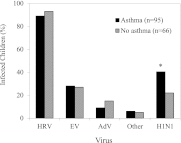Increased H1N1 infection rate in children with asthma
- PMID: 22366048
- PMCID: PMC3381233
- DOI: 10.1164/rccm.201109-1635OC
Increased H1N1 infection rate in children with asthma
Abstract
Rationale: The 2009 H1N1 flu appeared to cause more severe cold symptoms during the 2009-2010 flu season.
Objectives: We evaluated H1N1 infections during peak viral season in children with and without asthma to determine whether the H1N1 infectivity rate and illness severity were greater in subjects with asthma.
Methods: One hundred and eighty children, 4-12 years of age, provided eight consecutive weekly nasal mucus samples from September 5 through October 24, 2009, and scored cold and asthma symptoms daily. Viral diagnostics were performed for all nasal samples.
Measurements and main results: One hundred and sixty-one children (95 with asthma, 66 without asthma) completed at least 6 of the 8 nasal samples. The incidence of H1N1 infection was significantly higher in children with asthma (41%) than in children without asthma (24%; odds ratio, 4; 95% confidence interval, 1.8-9; P < 0.001), but rates of human rhinovirus infection (90% each) and other viral infections (47 vs. 41%) were similar. In children with asthma, there was a nonsignificant trend for increased loss of asthma control during H1N1 infections compared with human rhinovirus infections (38 vs. 21%; odds ratio, 2.6; 95% confidence interval, 0.9-7.2; P = 0.07).
Conclusions: During peak 2009 H1N1 flu season, children with asthma were infected almost twice as often with H1N1 compared with other respiratory viruses. H1N1 infection also caused increased severity of cold symptoms compared with other viral infections. Given the increased susceptibility of children with asthma to infection, these findings reinforce the need for yearly influenza vaccination to prevent infection, and raise new questions about the mechanism for enhanced susceptibility to influenza infection in asthma.
Figures



Comment in
-
First things first: protecting children with asthma from infection with influenza.Am J Respir Crit Care Med. 2012 Jun 15;185(12):i-ii. doi: 10.1164/rccm.201204-0621ED. Am J Respir Crit Care Med. 2012. PMID: 22707742 Free PMC article. No abstract available.
-
No H1N1 detected in children admitted to hospital with asthma during the H1N1 pandemic.Am J Respir Crit Care Med. 2012 Sep 1;186(5):462; author reply 463. doi: 10.1164/ajrccm.186.5.462. Am J Respir Crit Care Med. 2012. PMID: 22942348 No abstract available.
References
-
- Centers for Disease Control and Prevention Seasonal influenza vaccination coverage among children aged 6 months-18 years—eight immunization information system sentinel sites, United States, 2009–10 influenza season. MMWR Morb Mortal Wkly Rep 2010;59:1266–1269 - PubMed
-
- Jain S, Kamimoto L, Bramley AM, Schmitz AM, Benoit SR, Louie J, Sugerman DE, Druckenmiller JK, Ritger KA, Chugh R, et al. Hospitalized patients with 2009 H1N1 influenza in the United States, April–June 2009. N Engl J Med 2009;361:1935–1944 - PubMed
-
- Bloom B, Cohen RA, Freeman G. Summary health statistics for US children: National Health Interview Survey, 2008. Vital Health Stat 10 2009;1–81 - PubMed
-
- Miller EK, Griffin MR, Edwards KM, Weinberg GA, Szilagyi PG, Staat MA, Iwane MK, Zhu Y, Hall CB, Fairbrother G, et al. Influenza burden for children with asthma. Pediatrics 2008;121:1–8 - PubMed
-
- Desmoulins C, Michard-Lenoir AP, Naud J, Claudet I, Nouyrigat V, Chéron G. Clinical features and outcome of 2009 H1N1 influenza in the pediatric setting: multicenter prospective study in the ED [in French]. Arch Pediatr (In press) - PubMed

